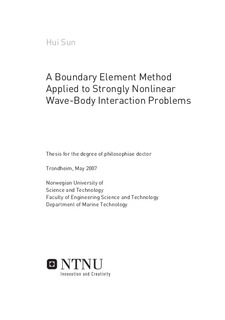| dc.contributor.author | Sun, Hui | nb_NO |
| dc.date.accessioned | 2014-12-19T12:05:11Z | |
| dc.date.available | 2014-12-19T12:05:11Z | |
| dc.date.created | 2008-02-17 | nb_NO |
| dc.date.issued | 2007 | nb_NO |
| dc.identifier | 123511 | nb_NO |
| dc.identifier.isbn | 978-82-471-3103-9 | nb_NO |
| dc.identifier.uri | http://hdl.handle.net/11250/237627 | |
| dc.description.abstract | A two-dimensional Boundary Element Method (BEM) based on potential flow theory is developed to study wave-body interaction problems with strongly nonlinear effects. In particular, the following problems are studied. One problem is the symmetric water entry of rigid bodies, i.e. of a wedge, a bow-flare ship section and a circular cylinder. Further, the asymmetric water entry of a bow-flare ship section, the water impact on an elastic cylindrical shell and the large-amplitude forced heave motions of a wedge and a bulbous-bow ship section are examined. Fully nonlinear free surface conditions are always satisfied. The exact body boundary conditions are also satisfied except in the water impact of a cylindrical shell. In this special case, the effects of the elastic vibrations are linearized and the body boundary conditions are satisfied on the undeformed shell surface. Gravity effects on the water flow are in general included.
The numerical difficulties encountered in solving the initial phase of the blunt body impact are handled by using flat plate theories, i.e. von Karman’s theory or Wagner’s theory at the initial stage. The numerical errors associated with the very thin jet rising up along the body surface are reduced by cutting off the thin jet. Thin sprays evolving from the free surface are cut off to avoid breaking waves hitting on the underlying free surface and thereby creating vorticity. A numerical damping beach in the far-field is utilized to ensure the condition of outgoing waves generated by an oscillating body.
A flow separation model is merged with the BEM to simulate the non viscous flow separation from the knuckles of a section or from a curved body surface. In the latter case, a criterion related to the low-pressure area on the wetted body surface near the free surface is introduced to predict the occurrence of the flow separation.
Hydroelasticity effects are accounted for in the water impact problem of a cylindrical shell by coupling the BEM with a modal analysis. An alternative approach is developed for cases when the submergence of the shell is small relative to its radius. In this approach, a flat plate theory, von Karman’s theory or Wagner’s theory, is coupled with the modal analysis.
Finally, the hydrodynamic performance of a prismatic planing hull in steady or unsteady motions is investigated by using a 2D+t theory combined with the two-dimensional BEM. The planing speeds are moderate in the studied cases. The three-dimensional effects neglected in the 2D+t theory and the gravity effects are discussed for the steady planing cases. In the unsteady cases, the planing hull is forced to oscillate in heave or pitch. The dependence of the linearized added mass and damping coefficients on the forced oscillation frequency is investigated. | nb_NO |
| dc.language | eng | nb_NO |
| dc.publisher | Fakultet for ingeniørvitenskap og teknologi | nb_NO |
| dc.relation.ispartofseries | Doktoravhandlinger ved NTNU, 1503-8181; 2007:141 | nb_NO |
| dc.title | A Boundary Element Method Applied to Strongly Nonlinear Wave-Body Interaction Problems | nb_NO |
| dc.type | Doctoral thesis | nb_NO |
| dc.contributor.department | Norges teknisk-naturvitenskapelige universitet, Fakultet for ingeniørvitenskap og teknologi, Institutt for marin teknikk | nb_NO |
| dc.description.degree | PhD i marin teknikk | nb_NO |
| dc.description.degree | PhD in Marine Technology | en_GB |
